
views
Practicing Basic Guiding

Have the blind person hold your arm just above the elbow. To start walking with a blind person, place the back of your hand on the back of the blind person's hand. This will let them figure out where your arm is. Then, the blind person can hold your arm just above the elbow. Don't grab onto the blind person. The blind person should always have the control to let go if need be. If you regularly guide blind people, you can get straps which to attach to your arm for the blind person to hold onto. The blind person may have a cane or guide dog. Guide dogs are typically held in the left hand unless there is a reason why not, such as being an amputee. Canes are typically held in their dominant hand. Let them use the hand without their cane or guide dog.
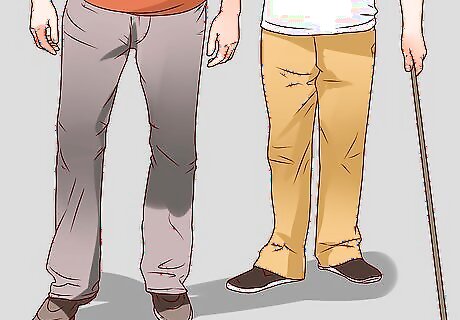
Make sure the blind person is a half step to a step behind you. The blind person should also be slightly to your left or right side. Keep up a pace you are both comfortable with. Periodically ask the blind person if they want to move faster or slower. Look out for obstacles. This includes obstacles on the ground, to the side, and anything head height. Instruct the blind person to move over or duck when necessary.

Have the blind person walk behind you in narrow spaces. In the event you have to walk through a narrow space, like a small hallway or a crowd of people, let the blind person know. You will have to adjust how you're walking when you encounter narrow spaces. The blind person will have to walk behind you in narrow spaces. Alert them that a narrow space is coming up. Then, instruct them how to move. Have the person step behind you. The blind person should still keep their hand on your arm, just below the elbow. You will have to move your guiding arm behind your back.
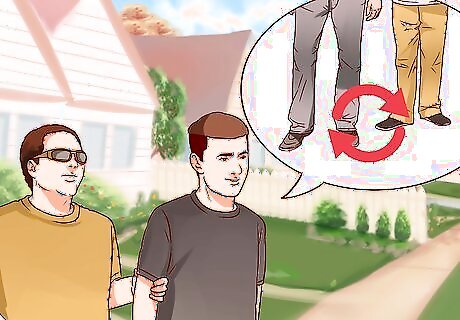
Let the blind person know if you need to switch sides. In some scenarios, you may have to switch sides when guiding a blind person. For example, you may encounter an obstacle in your own path while walking. Tell the blind person verbally that you need to switch sides. Have them pause while walking. It's much easier to switch sides when both you and the blind person are stationary. Have the blind person hold your guiding arm with both of their hands. Then, step in front of the blind person as you switch sides. As you move to the other side, the blind person can transition to grabbing your other arm. Before moving forward, make sure the blind person is holding one of your arms just above the elbow. Make sure they are a half step to a step behind you, a little to your side, before walking.
Navigating Special Circumstances

Use words in dangerous situations. You may encounter a dangerous situation when walking a blind person. There may be a speeding car, for example, or a loose dog. In such situations, remember the blind person cannot see the threat. Do not simply move them out of the way. Use your words to say something like, "Stop!" or "Move!" After you've gotten the blind person out of harm's way, explain the threat.

Move through doors. When guiding a blind person, you may have to help them through doors. In such a situation, make sure to take special precautions to make sure everything goes smoothly. Move your arm behind your back when going through a door, keeping their hand on your elbow. Make sure the blind person is on the hinged side of the door. If you need to change sides, do so following the instructions listed above. Explain which way the door opens as you near the door. Open the door and proceed to walk through with the blind person you are guiding. Have the blind person close the door behind them when you finish passing through.
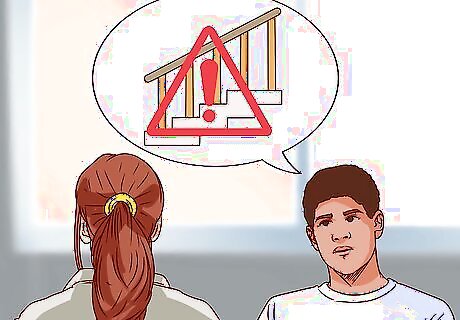
Navigate steps and staircases. Steps and staircases can be somewhat difficult to navigate. It's important you take safety precautions to avoid accident or injury. First, verbally inform the blind person when stairs are coming up. Tell them whether the stairs go up or down. Get to the edge of the stairs. Allow the blind person to let you know when they are ready to proceed. The blind person may want a moment to calibrate before proceeding up or down the staircase. Walk up or down the staircase, remaining one step ahead of the blind person. Go slowly to avoid injury. When you reach the top or bottom of the stairs, stop to let them catch up and let the blind person know. Describe any distinctive features of the stairs before. Inform them if there is a lot or a few stairs but don't count them as this can be distracting. Some stairs in public buildings have tactile markers at the top or bottom of stairs to let blind people know they are there. While helpful, you should still let them know verbally if there are stairs as well as if they're going up or down.

Use caution near curbs and roads. Curbs and roads are very dangerous, even with a guide. If you are guiding a blind person, make sure that you can use the Accessible Pedestrian Signals, which can provide tactile arrows and audible explanations about when to cross. You will need to push a button to activate the system, and may be able to adjust the sound. Cross the street at the narrowest point. Warn the person about curbs by saying "curb up" or "curb down." Approach a curb together. Make best use of accessibility patterns on streets. For example, some street lights will have a spinning cone underneath to let blind (especially deafblind) people know when to cross, if a blind person wants to use this, let them. Also be aware of tactile crossings as they can be helpful. Using dipped curbs can be helpful.
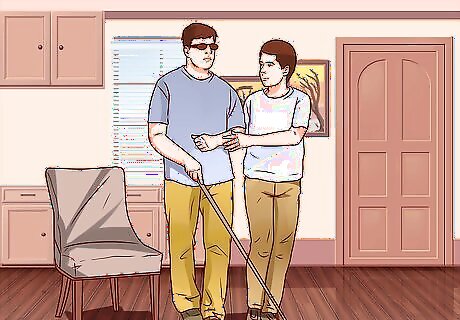
Help with seating. In addition to walking, you may need to help a blind person sit down. Tell the blind person which way a chair is facing. Walk up to the chair and place your guiding arm on the chair. Let the blind person know which part of the chair you are touching. The blind person can move their arm down yours, feel the chair, and figure out how to sit down from there.

Guide a blind person into a car. If you lead a blind person to their car, offer to help them into the car. Make sure you ask if the blind person needs assistance before helping. Let the blind person know which way the car is facing and which door you're opening. For example, say something like, "Okay, the car is facing forward and I'm going to help you into the passenger's seat." Take your guiding hand and place it on the door handle. Instruct the blind person to feel down your hand to find the handle. From here, you can usually let a blind person get in the car on their own. However, if it's an unfamiliar car you should place your arm inside the car on the roof. This can help the blind person feel how big the car is, avoiding bumping their head. Once the blind person is safely seated inside the car, allow them to close the door.

Assist them in the airport. Help them navigate through the airport, which will likely be busy and offers multiple opportunities for getting lost. Guide the individual to their seat, or ensure that they are partnered with personnel who have clearance to enter the plane if you are not travelling with them. Tell the airline that the passenger is blind when you book the ticket so that they can provide support services, such as pre-boarding. Individuals who use a cane are permitted to carry a white cane onto an airplane as long as it goes through the x-ray machine. Guide dogs are permitted aboard aircraft in some areas, including the United States and Canada, excepting Hawaii. If the passenger is travelling abroad, check the destination to see if they will permit the guide dog entrance or require special documentation, such as confirmation of rabies vaccinations. If you are traveling with a guide dog, ask to have the metal detector wand used instead of going through the tunnel. The dog's harness will set it off.
Being Respectful
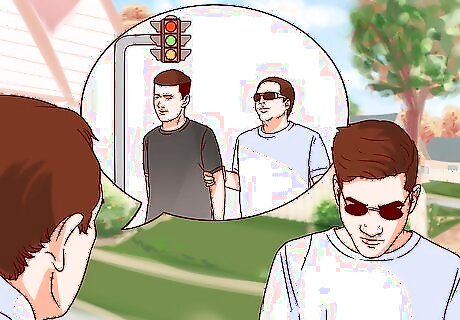
Approach, ask, and then assist. Many well-intentioned people see a blind person on the street and assume they should help. While it's a good idea to be helpful to those around you, you should never help someone without checking if they need assistance first. Approach and ask before you assist. Approach the blind person first. Greet them and introduce yourself. Say something like, "Hi there! I'm Michael." From there, politely ask if they need help. Try something like, "I noticed you're trying to cross the street and I was wondering if you needed any help." If the person needs help, they will usually let you know. Not all visually impaired people need assistance, so do not be offended if your offer is declined. Simply wish the person a good day and move on.

Do not be overprotective. Many blind or visually impaired people have been dealing with their disability for a long time. They are often used to navigating potential threats. While it's important you let a blind person know of a coming car or a low-hanging tree branch, try not to be overly protective. Only advise a blind person to move or duck when it's absolutely necessary.
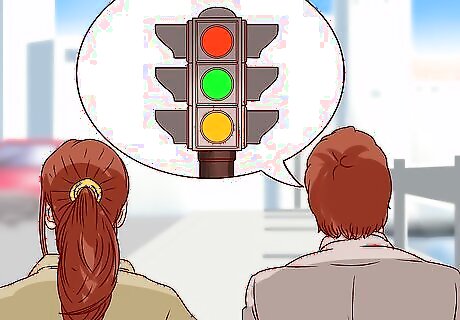
Describe the passing scene. Just as you might enjoy observing the scenery when you walk, many blind or visually impaired people enjoy having scenes described to them. When guiding a blind person, it can be nice to tell them about anything noticeable or interesting as you're walking. However, use discretion. Some people may prefer to walk in silence or may find excessive chatter distracting. It's a good idea to ask first before you describe the scene.
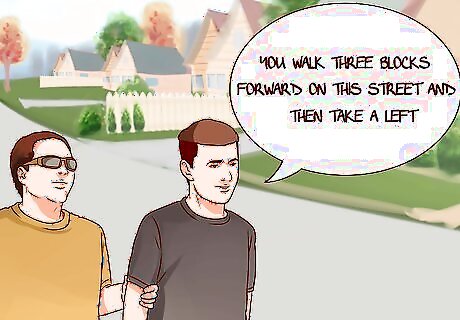
Give directions verbally. Many people use non-verbal cues, like pointing, when giving directions. You may do this without even thinking when giving directions to a blind person. However, try to remember you need to give out specific verbal directions for a blind person to understand. Say, "You walk three blocks forward on this street and then take a left." Do not point forward and say, "It's three blocks that way."



















Comments
0 comment